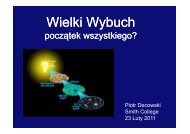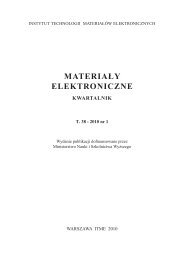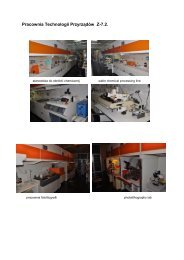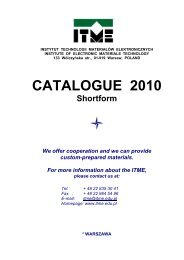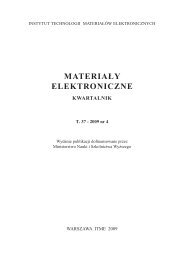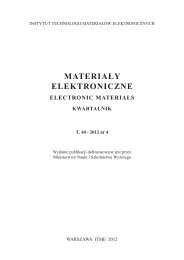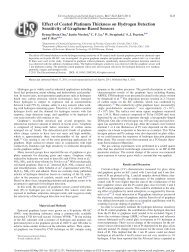MATERIAÅY ELEKTRONICZNE - ITME
MATERIAÅY ELEKTRONICZNE - ITME
MATERIAÅY ELEKTRONICZNE - ITME
Create successful ePaper yourself
Turn your PDF publications into a flip-book with our unique Google optimized e-Paper software.
Deep-level defects in epitaxial 4H-SiC irradiated...<br />
indications that it is related to a native defect whose<br />
formation is strongly affected by the composition of<br />
the gas phase during the CVD processes [1, 8, 18].<br />
Assuming that the Z 1/2<br />
center is associated with<br />
a native defect, like a carbon vacancy, as has been<br />
reported by Danno and Kimoto [19], we propose an<br />
alternative explanation of the doping level effect on<br />
the center concentration. It should be noted that the<br />
increase in the donor concentration results in the<br />
rise of the Fermi energy in relation to the valence<br />
band maximum. Since increase in the Fermi energy<br />
lowers the formation energy of native acceptors, the<br />
higher N concentration leads to the enhancement<br />
of the generation of these point defects during the<br />
epitaxial growth [14]. Thus, the concentrations of<br />
native point defects with multiple negative charge<br />
states strongly increase when the Fermi level shifts<br />
towards the conduction band minimum [20]. Hence,<br />
the observed rise in the Z 1/2<br />
center concentration may<br />
be explained by an indirect effect of the increase in<br />
the N concentration.<br />
The reported [8, 18], seemingly opposite, dependences<br />
of the Z 1/2<br />
center concentration on the C/Si<br />
ratio can therefore be understood, if we tentatively<br />
attribute this center to the divacancy V C<br />
V Si<br />
that consists<br />
of nearest-neighbor silicon (V Si<br />
) and carbon<br />
(V C<br />
) vacancies formed due to the removal of the Si<br />
and C atoms from different lattice sites – hexagonal<br />
(h) and cubic (k) or cubic (k) and hexagonal (h),<br />
respectively. According to DFT calculations [21],<br />
only the divacancies composed of vacancies located<br />
at different lattice sites (V Ch<br />
V Si<br />
k<br />
) or (V Ck<br />
V Si<br />
h<br />
) will<br />
exhibit such a negative-U behavior in 4H-SiC. Moreover,<br />
such divacancies are characterized by high<br />
thermal stability, similar to that observed for the Z 1/2<br />
center. It is worth noting that initially the Z 1/2<br />
center<br />
was suggested to be associated with such a V C<br />
V Si<br />
divacancy by Dalibor et al. [22].<br />
On the grounds of the theory of relative nativeand<br />
impurity-defect abundances in compound semiconductors<br />
and the factors that influence them [23],<br />
we can assume that at low C/Si values (~ 0.4 – ), the<br />
divacancy concentration is limited by the concentration<br />
of the silicon vacancies. In this case the residual<br />
concentration of the carbon vacancies is much higher<br />
(by more than one order of magnitude) than that<br />
of silicon vacancies. It should be noted, however,<br />
that a part of carbon vacancies can be involved in<br />
the formation of silicon antisites (Si C<br />
). In addition,<br />
silicon vacancy-silicon antisite pairs (V Si<br />
Si C<br />
) may<br />
also be formed.<br />
At high C/Si values (~ 1.5 – 3), the divacancy<br />
concentration is limited by the carbon vacancy<br />
concentration, however the significantly higher<br />
30<br />
concentration of the silicon vacancies can be reduced<br />
through the formation of carbon antisites (C Si<br />
).<br />
Apart from that, the complexes V C<br />
C Si<br />
can be also<br />
created. Thus, the influence of the C/Si ratio on the<br />
Z 1/2<br />
center concentration follows that on the V C<br />
V Si<br />
concentration. In other words, the Z 1/2<br />
center can be<br />
formed during the epitaxial growth either at lower<br />
values of the C/Si ratio, or at higher values of the<br />
C/Si ratio. So, there should be an optimal value of<br />
the C/Si ratio allowing for the minimization of the<br />
Z 1/2<br />
center concentration. This conclusion is consistent<br />
with the experimental results showing that the<br />
dependence of the Z 1/2<br />
center concentration on the<br />
C/Si ratio follows such a trend [8, 18].<br />
B. Deep-level defects in as-irradiated material<br />
Fig. 3 shows the DLTS spectra representative<br />
of the epilayers A and B after irradiation with low-<br />
-energy electrons. It is easily seen that the irradiation<br />
resulted in the formation of additional electron traps,<br />
labeled as TI2, TI3, TI4 and TI5. It is interesting to<br />
note that the Z 1/2<br />
center is not observed in these spectra.<br />
This is due to the fact that after the irradiation, the<br />
capacitance of the depletion region in the Schottky<br />
diodes on epilayers A and B, measured at zero bias<br />
at the temperature of 300 K, dropped from 10.5 to<br />
4.4 pF and from 19.6 to 6.0 pF, respectively. In other<br />
words, the shallow donors in the both epilayers were<br />
almost fully compensated with the Z 1/2<br />
acceptors<br />
that arose during the irradiation. On the other hand,<br />
at the temperature of 350 K, the capacitance values<br />
were nearly such as at 300 K before the irradiation.<br />
Taking into account that in the range of 300 – 350 K<br />
the thermal emission rate of electrons trapped at Z 1/2<br />
centers increases from ~ 77 to ~ 3416 s -1 , we can<br />
assume that the capacitance changes observed with<br />
increasing the temperature are due to the change in<br />
the charge state of the Z 1/2<br />
centers induced in the<br />
both epilayers by the low-energy electron irradiation.<br />
Thus, at 300 K, the vast majority of the centers are<br />
occupied by electrons and being negatively charged<br />
compensate positively charged nitrogen donors. At<br />
350 K, the centers are mostly neutral and compensation<br />
almost disappears, as the thermal emission rate<br />
of electrons is sufficiently high.<br />
As it seen in Fig. 3, the trap TI2, with the activation<br />
energy of 0.71 eV, only was observed in the<br />
epilayer B, which had a higher nitrogen concentration<br />
equal to 4.0 × 10 15 cm -3 . For all the traps detected in<br />
as-irradiated epilayers, the plots of log(T 2 /e n<br />
) versus<br />
1/kT, where e n<br />
is the electron thermal emission rate<br />
and k is the Boltzmann constant, are presented in




